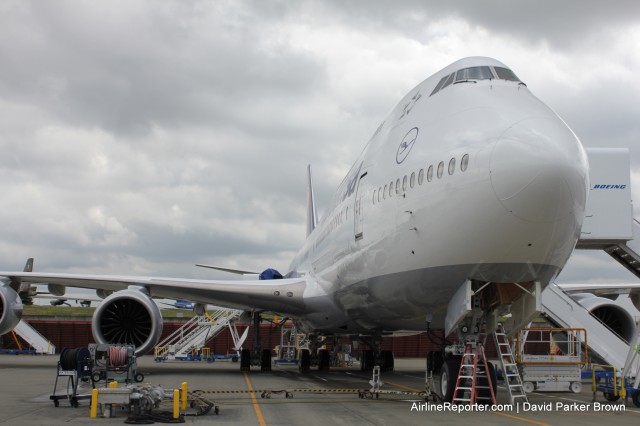
The 1,500th Boeing 747 (70th 747-8) sitting on the flight line at Paine Field
The 747 Jumbo Jet is an iconic aircraft. For years, it was the only double-deck commercial airliner and for many it is a favorite. From its first flight in 1969, the 747 has changed quite a bit. The newest iteration, the 747-8, might sport a similar shape to the original 747 or the 747-400, but it is quite a different beast (more than just LED lighting). This past weekend, the 1,500th 747 was delivered to Lufthansa Airlines. About a week earlier, Boeing took the opportunity to talk about their largest commercial airliner and its future relevance.
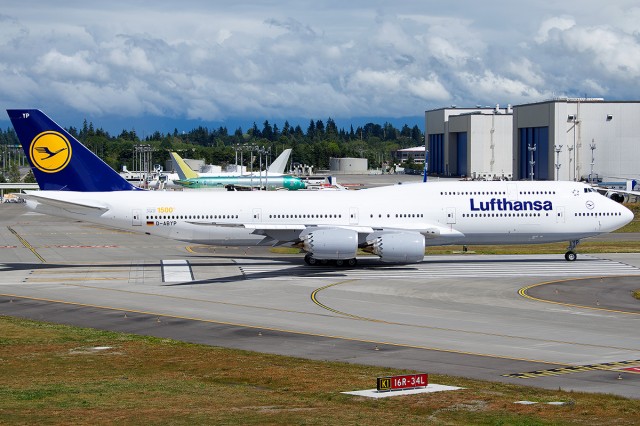
LN1500 lining up for take off – Photo: Bernie Leighton | AirlineReporter
I was invited to Boeing’s factory in Everett to sit down with Eric Lindblad, vice president and general manager of the 747 program, and we had a down-to-earth conversation about where the 747 has been, where it is today, and where Boeing is hoping it is going.
The big message that Lindblad wanted to get across is, “this is not your mother’s 747.” Not only is the 747-8I a very different aircraft than the 747-400, but the 70th 747-8 is much more efficient than the first one, and they plan to keep making it more efficient.
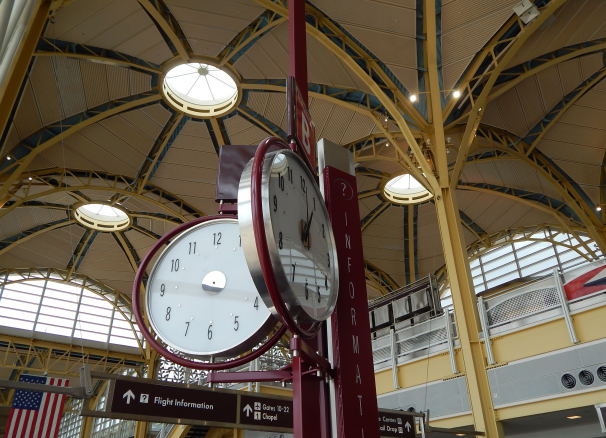
A Travelers Aid desk at DCA – Photo: Ryan Ewing
I love airplanes and sometimes I think airplanes love me. It is hard to fathom that these beautiful, curiosity-instilling works-of-art can fly. Throughout my life, I have always had a strong interest in aviation. My parents tell me that I would always ask a family friend, a pilot for a major carrier, questions about airplanes. I never caught the aviation bug – I was just born with it.
It was a summer day in May of 2013 when I came to the realization that I needed to find something to do during the summer besides sitting on the computer or watching TV. I talked to some people and found an organization called Travelers Aid International. Initially, I didn’t know Travelers Aid even existed, but I knew this would be a perfect place for me. I contacted the organization at Ronald Reagan Washington National Airport (DCA) and they sent me a very kind response telling me where to meet for the interview. There, during the interview, was where I would start something that I would never be able to end.
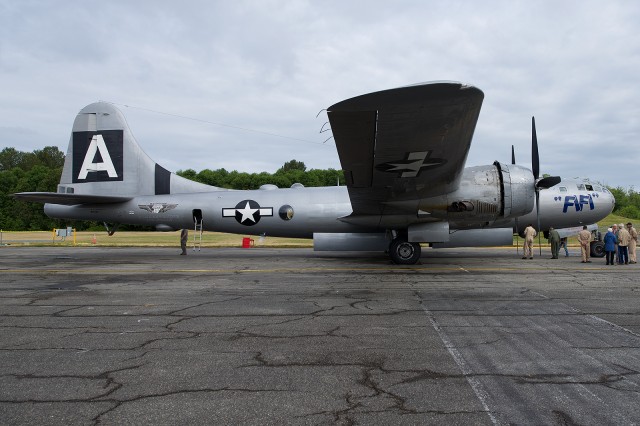
Side on with a B-29A – Photo: Bernie Leighton | AirlineReporter
It’s rare to get to fly on something unique, but the Commemorative Air Force has an aircraft that can fit the bill. Most of our readers probably are familiar with the fact that they operate a Boeing B-29 Superfortress (NX529B), more popularly known as FIFI.
FiFi is a 1945 model B-29; in other words, produced after the war. Originally, it was delivered to an Army Air Forces facility in Kansas. Following that, it was converted to a TB-29A for use as a crew trainer. In 1958, it ended up at Naval Air Weapons Station China Lake. There it sat on the range as a target. Miraculously, it was not destroyed, and was acquired by the Commemorative Air Force in 1971. They have been taking exceptional care of the airframe ever since.
As part of the 2014 Air Power Tour, it arrived at Paine Field on June 19th, and I was scheduled to fly on it the next day.
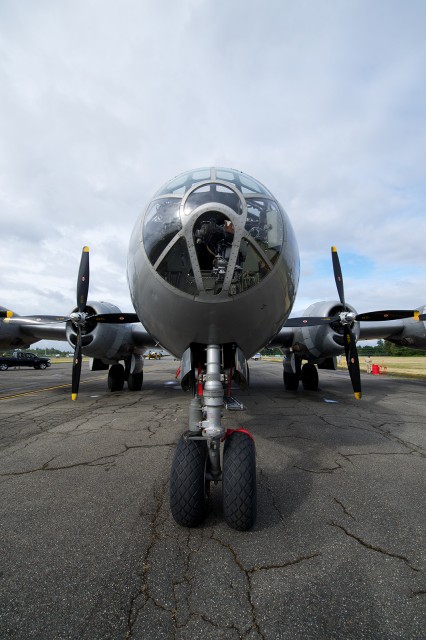
Nose-on with FIFI – Photo: Bernie Leighton | AirlineReporter
FIFI is a gem of an aircraft, in better condition than most things I fly on recreationally. Not that such a statement says much on its own, but it legitimately looks like it could have rolled off the assembly line yesterday- not sixty-nine years ago.
While Boeing was clearly the primary contractor on all B-29s, and they were produced right here in Renton (though Martin and other companies made their share in Georgia), there was a phenomenal degree of subcontracting. The hydraulically-braked landing gear was actually produced by Chevrolet, for instance. I mention it as it still bares the signature Chevy mark.
Boarding a B-29 is also a bit different. One goes in via a ladder located in the nosewheel gear bay.
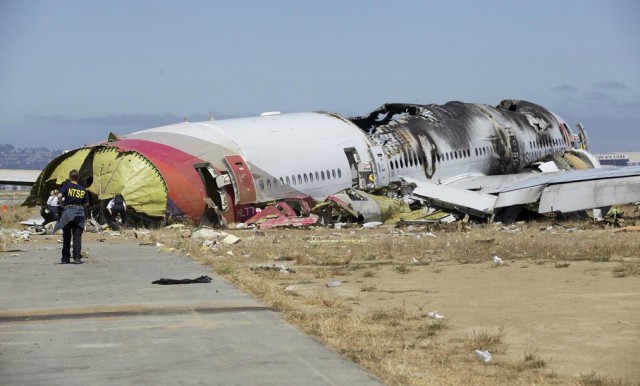
Asiana Airlines flight 214 crash, a Boeing 777 – Photo: NTSB
The National Transportation Safety Board (NTSB) this week released a synopsis of their final report on last year’s crash of Asiana Airlines flight 214 at San Francisco International Airport (SFO). The report lists NTSB’s findings, identifies a probable cause, and makes 27 specific recommendations to Asiana, the FAA, and Boeing – among others. The crash was found to be pilot error – the result of a botched visual approach which culminated in the Boeing 777-200ER hitting a seawall and crashing onto the runway, killing three and seriously injuring dozens.
For anyone who has followed the crash investigation, there were no real surprises in the report. However, there are some interesting takeaways.
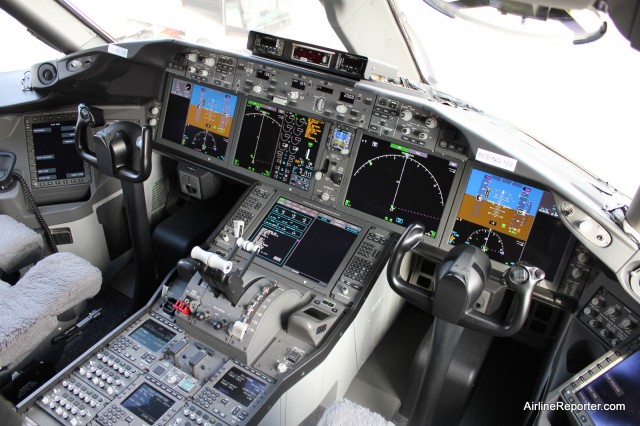
787 cockpit showing TCAS on the Multi-Function Display – Photo: AirlineReporter
A few months ago, a near-collision between two Boeing 757s off the coast of Hawaii was in the headlines. This event was particularly noteworthy because of the emergency descent made by United Airlines Flight 1205, which descended over 600 feet in a matter of seconds, terrifying passengers and sending items flying in the cabin. The pilots on the United flight were alerted to the oncoming traffic, and took action based on their Traffic Collision Avoidance System (TCAS).
History of mid-air incidents and TCAS mandate
Although TCAS systems are a (relatively) recent development in airline cockpits, the need for such systems was recognized long ago. On June 30,1956, a mid-air collision occurred at 20,000 feet between a United Airlines DC-7 and a TWA Lockheed 1049 over the Grand Canyon in northern Arizona. This incident, which resulted in 128 fatalities, served as a wake-up call for the aviation industry. Prior to the collision, ’œbig sky theory’ was the prevailing notion – that two aircraft flying in three-dimensional space were very unlikely to collide. Following this incident (which also led to the creation of the FAA), research began on developing collision avoidance systems.






